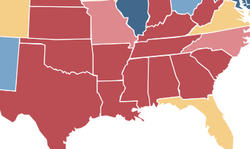What’s going on in the Southern swing states?
In 2008, President Barack Obama managed an historic accomplishment: He was not only elected as the first African American in the White House, he got there in part due to becoming the first Democrat in decades to win the Southern states of Florida, North Carolina and Virginia.
Four years later, what are Obama’s prospects in the Southern swing states, which now account for 57 Electoral College votes? And what does it say about the state of Southern politics?
There’s little doubt that Obama faces an uphill battle to repeat his 2008 Southern trifecta. The poll numbers are always changing, and a lot can happen between now and when the polls close Nov. 6. But the work Obama and the Democrats have cut out for them is clear:
* Virginia is Obama’s best hope in the South. He won the state by more than 230,000 votes in 2008, and it still ranks with Ohio among the most hotly-contested national battlegrounds. In the polls, Obama averages a miniscule .8-point lead. According to The New York Times’ popular poll-watching blog FiveThirtyEight, as of now that translates into an equally-narrow 54 percent chance of Obama winning the state.
* Florida has some Democrats more worried. After Obama won the state by 2.5 points in 2008 — and enjoying good polling numbers at different times in 2012 — there’s sharp debate about his chances this time around. In a reverse image of Virginia, Romney leads the polls by a mere .6 points. But FiveThirtyEight’s analysis finds a state where Obama has struggled to gain traction; right now, they peg his odds of winning Florida at just 35 percent.
* And then there’s North Carolina. Democrats insist it’s still in play, and point to recent good-news polls as proof of revival in a state Obama won by just over 14,000 votes in 2008. Democratic National Committee Chair Debbie Wasserman Schultz told CNN — unconvincingly, to some — that the Dems had “planted a flag” in North Carolina and were still committed to it.
The Obama campaign’s strategy in North Carolina has been hard to fathom, perhaps intentionally: On one hand, he famously skipped the state in a recent swing-state tour, and left North Carolina out of a recent round of ad buys. But now Obama’s bumped up advertising in the state again. The campaign claims their focus on “ground game” is the reason Democrats have made up 53 percent of early voters so far; the early voting rate is up 22 percent from 2008.
What do the polls say? Going by averages, Romney has only a 1.6-point advantage in North Carolina. But like Florida, FiveThirtyEight thinks Obama has too much catching up to do; they currently a meager 19 percent chance of winning N.C.
HOW MANY VOTES? AND IS THE SOUTH REALLY THAT DIFFERENT?
So what does this mean for Nov. 6? How many votes would Obama need to catch up — or, in Virginia’s case, maintain his sliver of a lead?
To figure this out, I looked at the number of registered voters in each state. Using an estimate of voter turnout — the average in the last three presidential elections — I applied FiveThirtyEight’s estimate of the percentage of voters that would cast ballots for Obama and Romney if the election were held today.
Here’s what the totals look like, and how much of a shift that represents from 2008:
In each case, the actual vote margin isn’t huge — and especially in the case of Florida, entirely surmountable. And again, that assumes the polls are accurate or a good predictor of who will actually show up to vote.
One other thing stands out from the data: Obama’s prospects may, as of now, appear to have dimmed in the Southern swing states compared to 2008 — but not any worse than they have in other parts of the country.
Obama beat Republican John McCain by 7.2 points in the national popular vote in 2008. FiveThirtyEight projects that if the election were held today, Obama would get 50.2 percent of the national popular vote to Romney’s 48.7 percent — a mere 1.5 point advantage, or a 5.7 drop-off from his 2008 national victory margin. That’s compared to a predicted 3.5- to 5.9-point decline in the Southern battlegrounds.
In other words, despite the temptation of some pundits to suggest Obama’s prospects in the South are uniquely challenging, the reality is that polls show Obama’s changing prospects in the Southern swing states are completely in line with what’s happened nationally.
And given the close margins, voters across the South still have plenty of time to prove all the pundits and pollsters wrong.
–Chris Kromm, Institute for Southern Studies




